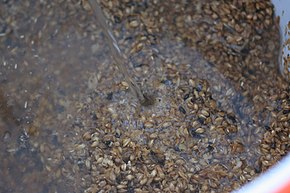Our website is made possible by displaying online advertisements to our visitors.
Please consider supporting us by disabling your ad blocker.
Mashing

In brewing and distilling, mashing is the process of combining a mix of ground grains – typically malted barley with supplementary grains such as corn, sorghum, rye, or wheat (known as the "grain bill") with water and then heating the mixture. Mashing allows the enzymes in the malt (primarily, α-amylase and β-amylase) to break down the starch in the grain into sugars, typically maltose to create a malty liquid called wort.[1]
The two main methods of mashing are infusion mashing, in which the grains are heated in one vessel, and decoction mashing, in which a proportion of the grains are boiled and then returned to the mash, raising the temperature.[2]
Mashing involves pauses at certain temperatures (notably 45–62–73 °C or 113–144–163 °F) and takes place in a "mash tun" – an insulated brewing vessel with a false bottom.[3][4][5]
- ^ Cite error: The named reference
Ensminger1994was invoked but never defined (see the help page). - ^ Cite error: The named reference
Rabin1998was invoked but never defined (see the help page). - ^ "Abdijbieren. Geestrijk erfgoed" by Jef Van den Steen
- ^ "Bierbereiding". 2008-04-19. Archived from the original on 2008-04-19. Retrieved 2018-11-04.
- ^ "How To Brew Your First Beer: Chapter 14 - How the Mash Makes Wort". www.realbeer.com. Retrieved 2018-11-04.
Previous Page Next Page


